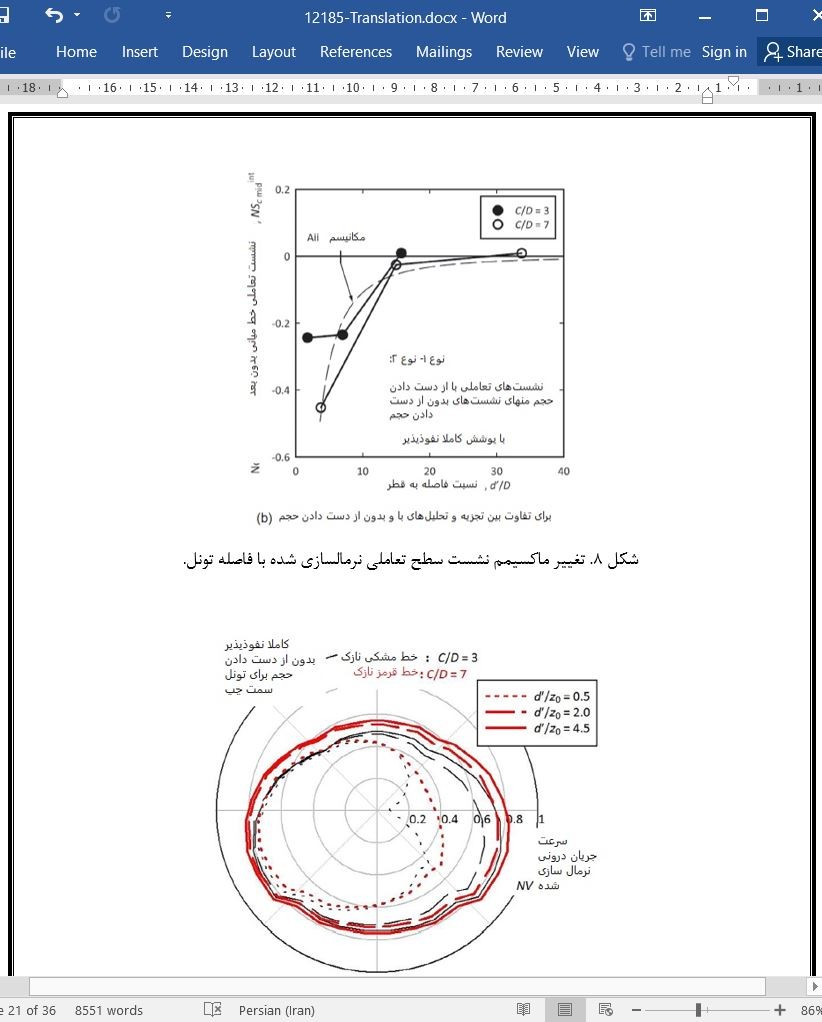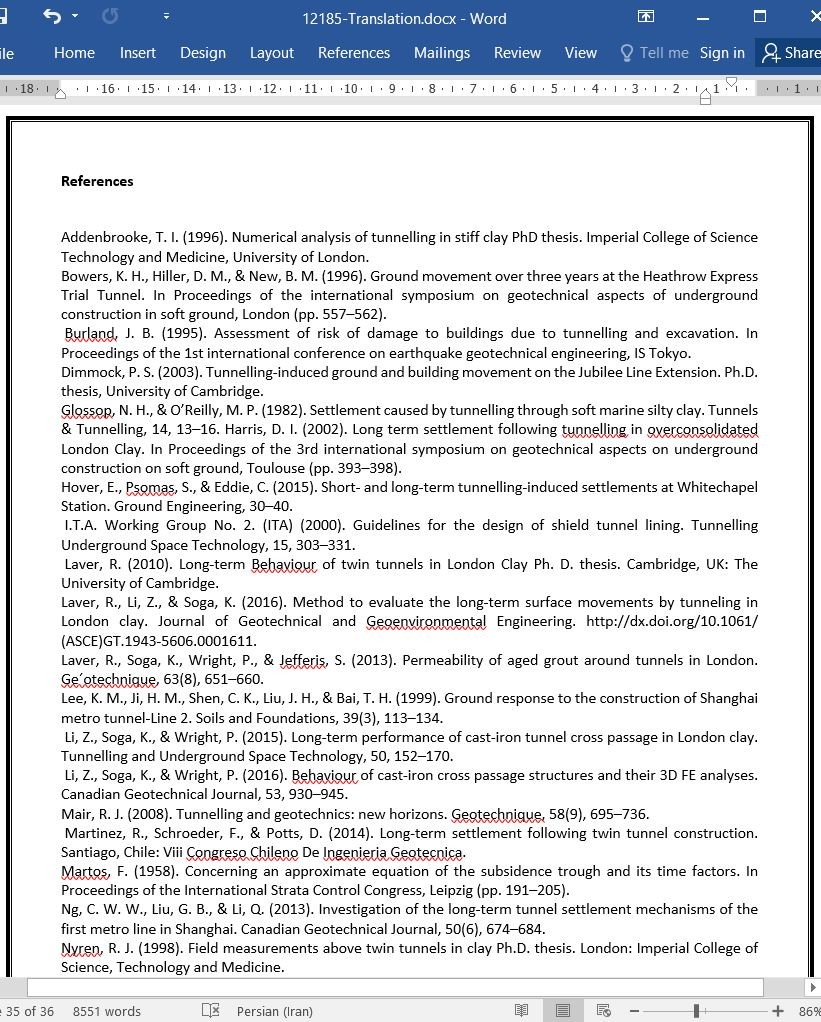
رفتار طولانی مدت تونل و حرکات زمین پس از تونل زنی در خاک های رسی
چکیده
حرکات طولانی مدت زمین در بالا تونل ممکن است با گذشت زمان پس از تونلزنی خاکهای رسی، به افزایش ادامه دهد زیرا فشارهای آب منفذی بیش از حد القا شده توسط تونلزنی پراکنده میشوند، در حالی که فشار متغیر زمین که روی تونل اعمال میشود منجر به تغییر شکل تونل در طول تحکیم میشود. علاوهبراین، خود تونل، شرایط زهکشی جدیدی را معرفی میکند؛ یعنی، بسته به شرایط زهکشی خطکشی (پوشش) تونل، تنشهای موثر حول تونل، با گذشت زمان تغییر کرده و تحکیم (استحکام) بیشتر خاک را القا میکنند. میزان نشست (نفوذ) از خاک رسی با نفوذپذیری پایین اغلب بسیار کوچک بوده و نشست (نفوذ) آب زمین در تونل میتواند به سرعت بخار شود. اگرچه تونل ممکن است به نظر نشست ناپذیر برسد چون سطح به نظر خشک میرسد، این احتمال وجود دارد که شرایط زهکشی تونل در واقع نشست پذیر (نفوذپذیر) باشد. این مقاله به بررسی تعامل تحکیم خاک-تونل، به ویژه با تمرکز روی حرکات سطح زمین و تغییر شکل پوشش تونل در جهت رفع دغدغههای مهندسان میپردازد. نتایج تجزیه و تحلیل نشان میدهند که گذردهی پوشش تونل نسبت به نفوذپذیری زمین اطراف، نقش مهمی در هر دوی حرکات طولانی مدت زمین و رفتار پوشش تونل دارد. یافتههای منتشر شده در تحقیقات، به صورت گام به گام با شروع از یک تونل منفرد، تونلهای دوقلو تا ساختارهای گذر عرضی پیچیده مورد بررسی قرار میگیرند. مکانیسمهای تحکیم خاک القا شده توسط تونلزنی برای این ساختارها شناسایی میشوند و در صورت امکان، متدلوژیهای ممکن مهندسی برای ارزیابی اندازه نشستهای سطح زمین و بارگذاریهای پوشش تونل ارائه میشوند.
پیشگفتار
در خاکهای رسی، حرکات زمین در بالای تونل میتوانند به ایجاد ساختار بعدی ادامه دهند، در حالی که تونل، با تحکیم خاک، تغییر شکلی را توسعه میدهد (به عنوان مثال، باورز، هیلر و نیو، 1996؛ هریس، 2002؛ لیور، سوگا، رایت و جفریس، 2013؛ نیرن، 1998؛ اوریلی، میر، و آلدرمن، 1991؛ پک، 1969؛ شیرلاو، 1995). افزایش نشست تحکیم ممکن است منجر به آسیبهایی در ساختمان سطحی شود، به عنوان مثال، همانطور که توسط هریس (2002) اشاره شده است، در بالای تونلهای Jubilee Line Extension در لندن، تغییر شکل طولانی مدت تونل ممکن است منجر به ترک خوردگی، نفوذ آب، و جابجاییهای دیفرانسیلی با خطر خارج شدن از خط برای ایمنی تونل شود (شن، وو، کوی و یین، 2014).
خاتمه و توصیههای برای مطالعه آینده
تونلها اغلب برای چند دهه یا بیشتر مورد استفاده قرار میگیرند. این مقاله به توصیف مکانیسمهای مختلف حرکات طولانی مدت زمین و رفتار تونل پس از تونلزنی در خاکهای رسی بر اساس مجموعهای از تجزیه و تحلیلهای عنصر متناهی 3 بعدیِ انجام شده و تفسیر مطالعات موردی میدانی محدود میپردازد. یک تونل منفرد، جریان نشت شعاعی را در اطراف تونل در طول تحکیم خاک تولید میکند. تونلهای دوقلو و گذرهای عرضی، توسعه تنش موثر و فشار منفذی حول تونل را با گذشت زمان از شرایط نشت شعاعی تغییر میدهند و بنابراین، تعامل پیچیده تونل-خاک رخ میدهد. در این مقاله، رفتار طولانی مدت یک تونل منفرد، تونلهای دوقلو و گذرهای عرضی با تاکید ویژه روی حرکات زمین سطحی و رفتار پوشش تونل مورد بحث قرار میگیرد.
Abstract
Long term ground movements above a tunnel may continue to increase with time after tunnelling in clayey soils as the tunnelling-induced excess pore water pressures dissipate, whilst the changing earth pressure acting on the tunnel leads to further tunnel deformation during consolidation. Furthermore the tunnel itself introduces new drainage conditions; that is, depending on the drainage condition of the tunnel lining, the effective stresses around the tunnel change with time, inducing further soil consolidation. A seepage rate from low permeability clayey soil is often very small and the groundwater seeping into the tunnel can evaporate quickly. Although a tunnel may look impermeable because the surface looks dry, it is possible that the tunnel drainage conditions are actually permeable. This paper summarises the investigation of soil-tunnel consolidation interaction, particularly focusing on ground surface movements and tunnel lining deformation in the interest of engineering concerns. Analysis results show that tunnel lining permittivity relative to the permeability of the surrounding ground plays an important role on both long-term ground movements as well as tunnel lining behaviour. The findings published in literature are reviewed step by step starting from a single tunnel, twin tunnels to complex cross passage structures. The mechanisms of tunnelling-induced soil consolidation for these structures are identified and, where applicable, possible engineering methodologies to assess the magnitude of long-term ground surface settlements and tunnel lining loads are proposed.
Introduction
In clayey soils, ground movements above a tunnel can continue to build up following construction whilst the tunnel develops a further deformation as the soil consolidates (e.g. Bowers, Hiller, & New, 1996; Harris, 2002; Laver, Soga, Wright, & Jefferis, 2013; Nyren, 1998; O’Reilly, Mair, & Alderman, 1991; Peck, 1969; Shirlaw, 1995). The increasing consolidation settlement may induce surface building damages, for example, as reported by Harris (2002), above the Jubilee Line Extension tunnels in London, whilst long-term tunnel deformation may lead to cracks, water infiltration and differential displacements at risk of derailment for tunnel safety (Shen, Wu, Cui, & Yin, 2014).
Closure and recommendations for future study
Tunnels are often used for decades or even longer. This paper describes various mechanisms of long-term ground movements and tunnel behaviour after tunnelling in clayey soil based on a series of 3D finite element analyses conducted and interpretation of limited field case studies. A single tunnel generates a radial seepage flow around the tunnel during soil consolidation. Twin tunnels and cross passages alter the development of the effective stress and pore pressure around the tunnel with time from the radial seepage condition and therefore complex tunnel-soil interaction occurs. In this paper, the long term behaviour of a single tunnel, twin tunnels and cross passages are discussed with particular emphasis on surface ground movements and tunnel lining behaviour.
چکیده
پیشگفتار
مکانیسم زهکشی تونل
تونل منفرد
حرکات زمین
حرکات عمودی
حرکات افقی
رفتار پوشش
تونلهای دوقلو
حرکات زمین
مکانیسم A: تعامل میدان کرنش
مکانیسم B: محدودیت تامین جریان
مکانیسم C: فشردگی عرضی خاک
مکانیسم A
رفتار پوشش تونل دوقلو
تونلهای گذر عرضی
خاتمه و توصیههای برای مطالعه آینده
منابع
Abstract
Introduction
Tunnel drainage mechanism
Single tunnel
Ground movements
Vertical movements
Horizontal movements
Lining behaviour
Twin tunnels
Ground movements
Mechanism A – Seepage
Mechanism B: Flow supply restriction
Mechanism C: Lateral soil compression
Twin tunnel lining behaviour
Cross passage tunnels
Cross passage tunnel behaviour
Closure and recommendations for future study
Appendix A. Evaluation method
References
- اصل مقاله انگلیسی با فرمت ورد (word) با قابلیت ویرایش
- ترجمه فارسی مقاله با فرمت ورد (word) با قابلیت ویرایش، بدون آرم سایت ای ترجمه
- ترجمه فارسی مقاله با فرمت pdf، بدون آرم سایت ای ترجمه



